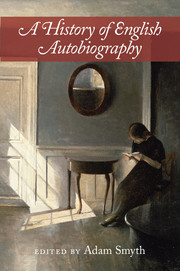Book contents
- Frontmatter
- Dedication
- Contents
- List of contributors
- 1 Introduction: The range, limits, and potentials of the form
- PART 1 AUTOBIOGRAPHY BEFORE ‘AUTOBIOGRAPHY’ (CA. 1300–1700)
- PART 2 RELIGION, GENDER, THINGS (CA. 1700–1800)
- 8 Structures and processes of English spiritual autobiography from Bunyan to Cowper
- 9 ‘Written by herself’: British women's autobiography in the eighteenth century
- 10 The lives of things: Objects, it-narratives, and fictional autobiography, 1700–1800
- 11 Empiricist philosophers and eighteenth-century autobiography
- PART 3 THE MANY NINETEENTH CENTURIES (CA. 1800–1900)
- PART 4 RELATIONAL LIVES AND FORMS OF REMEMBERING (CA. 1890–1930)
- PART 5 KINDS OF COMMUNITY (CA. 1930-CONTEMPORARY)
- Index
- References
9 - ‘Written by herself’: British women's autobiography in the eighteenth century
from PART 2 - RELIGION, GENDER, THINGS (CA. 1700–1800)
Published online by Cambridge University Press: 05 March 2016
- Frontmatter
- Dedication
- Contents
- List of contributors
- 1 Introduction: The range, limits, and potentials of the form
- PART 1 AUTOBIOGRAPHY BEFORE ‘AUTOBIOGRAPHY’ (CA. 1300–1700)
- PART 2 RELIGION, GENDER, THINGS (CA. 1700–1800)
- 8 Structures and processes of English spiritual autobiography from Bunyan to Cowper
- 9 ‘Written by herself’: British women's autobiography in the eighteenth century
- 10 The lives of things: Objects, it-narratives, and fictional autobiography, 1700–1800
- 11 Empiricist philosophers and eighteenth-century autobiography
- PART 3 THE MANY NINETEENTH CENTURIES (CA. 1800–1900)
- PART 4 RELATIONAL LIVES AND FORMS OF REMEMBERING (CA. 1890–1930)
- PART 5 KINDS OF COMMUNITY (CA. 1930-CONTEMPORARY)
- Index
- References
Summary
There are fewer autobiographies by eighteenth-century British women and men than we may realise. William Matthews, the foremost bibliographer of the subject, says there are around four hundred in total, but in fact there are far fewer (Matthews 1973, 3). In the case of women's autobiography, by my count there are under thirty known narratives, not including very short ones, by women born in Britain, though others are undoubtedly hidden in manuscripts in libraries and family archives.
Felicity Nussbaum noted nearly thirty years ago that there was no history of ‘women's autobiographical writing’ for the century, and that remains true (Nussbaum 1989, 128). Nevertheless, a generation of feminist scholars, including but not limited to the pioneering Patricia Meyer Spacks, Felicity Nussbaum, Amy Culley, Dianne Dugaw, Cristine Levenduski, and Lynda M. Thompson, have greatly forwarded our understanding of eighteenth-century women's autobiography. In the eighteenth century, autobiographies of both men and women appeared in greater numbers than in the seventeenth century, and the voices of women who would not have written or been published earlier were heard. Some women preachers spoke in print. Actresses, women accustomed to presenting themselves to an audience and to playing roles (from 1660), began to represent themselves in autobiographies. In their books, these women are constructing the selves they are, or want their audience to believe they are, often in opposition to received opinions. As Mary Poovey, drawing on Patricia Meyer Spacks, puts it, ‘The struggle to be a self takes place simultaneously with the effort to express the self’ (Poovey 1985, 41). ‘Scandalous memoirs’ were published by women (often actresses) whose sexual liaisons would not have been self-described by them in the past.
The word ‘autobiography’ itself did not appear in a title until the nineteenth century, or indeed at all before 1797 (Folkenflik 1993, 3–6). One could plausibly argue that there were no autobiographies in the century, only memoirs, but that term is too broad, covering both autobiography and biography, as well as events recounted from personal knowledge, such as Sarah, Duchess of Marlborough's account of her years at court (1742). Wayne Shumaker notes that the earlier in time one focuses on autobiography, the more expansive one's definition is likely to be (Shumaker 1954, 2).
- Type
- Chapter
- Information
- A History of English Autobiography , pp. 119 - 132Publisher: Cambridge University PressPrint publication year: 2016
References
- 1
- Cited by



